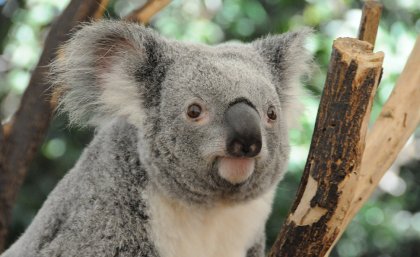
Cars and chlamydia were the top causes of a dramatic rise in south-east Queensland koala deaths over the past two decades, according to a new University of Queensland-led study.
UQ School of Veterinary Science’s Associate Professor Rachel Allavena and Dr Joerg Henning worked with the Queensland Government’s Moggill Koala Hospital to analyse data about koala disease and death from 1997 to 2013.
Dr Allavena said the important data had been collected over the span of the koala population crash.
“Populations throughout the ‘Koala Coast’ declined by about 80 per cent over this period, so this iconic and famous species is in real trouble in our area,” she said.
The senior researchers and PhD student Viviana Gonzalez-Astudillo determined that at least a quarter of the koalas hit by cars were otherwise in good health, meaning it was healthy, breeding animals that were killed.
About half of the population that died over the study period was affected by more than one disease or health problem, including trauma.
Chlamydia was particularly devastating for koalas, because of the potential to render females infertile and cause bladder and eye problems, making predator avoidance and food foraging harder.
Animal attacks, particularly from dogs, and wasting away from starvation, disease and poor teeth were other prominent causes of koala deaths.
Dr Henning said the research team had developed KoalaBASE, a web-based database about koalas coming into care in south-east Queensland facilities.
“KoalaBASE enables data input at multiple veterinary centres, and use of the data by multiple stakeholders such as veterinarians, government departments and researchers,” Dr Henning said.
The UQ researchers hope their data, published in the journal Scientific Reports, will help government agencies, koala groups and hospitals better target resources to prevention and treatment.
Environment Minister Dr Steven Miles said the Department of Environment and Heritage Protection, which funded the $420,723 research project, provided extensive records of koala admissions at Moggill Koala Hospital.
“Based on this information and its own research with other koala care facilities, the research team has developed a database which, for the first time, provides accurate scientific information on the specific threats facing south-east Queensland koalas,” Dr Miles said.
“This is one of several projects funded by the State Government to boost our knowledge and understanding of the threats facing koalas, so we can ensure work to secure viable and healthy koala populations across the state is based on evidence and scientific research.”
“The Palaszczuk Government takes the protection of the State’s much-loved koalas very seriously and has set up a Koala Expert Panel and invested $12.1 million over four years to this cause.”
The largest prospective mortality study on koalas undertaken – drawing on autopsies of more than 500 koalas that died of natural causes – is soon to be published by UQ researchers.
Media: Dr Joerg Henning, j.henning@uq.edu.au, +61 7 5460 1846; Associate Professor Rachel Allavena r.allavena@uq.edu.au , +61 7 5460 1826. Viviana Gonzalez-Astudillo, v.gonzalez@uq.edu.au, +61 7 5460 1098.



